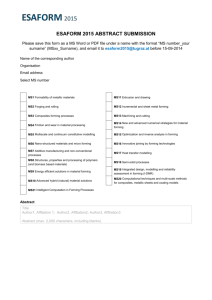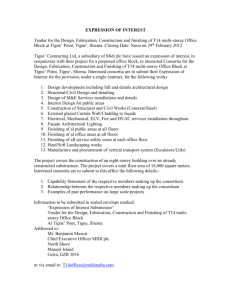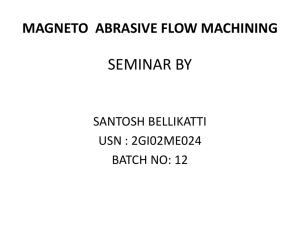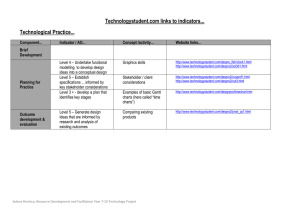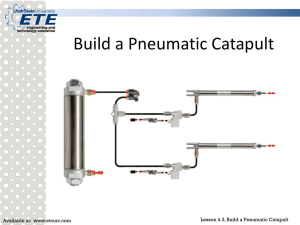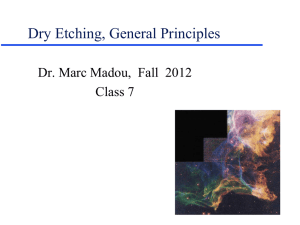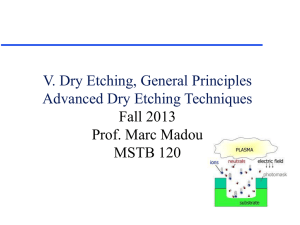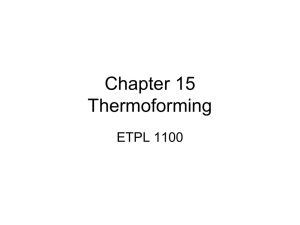Describe - The Parker E
advertisement
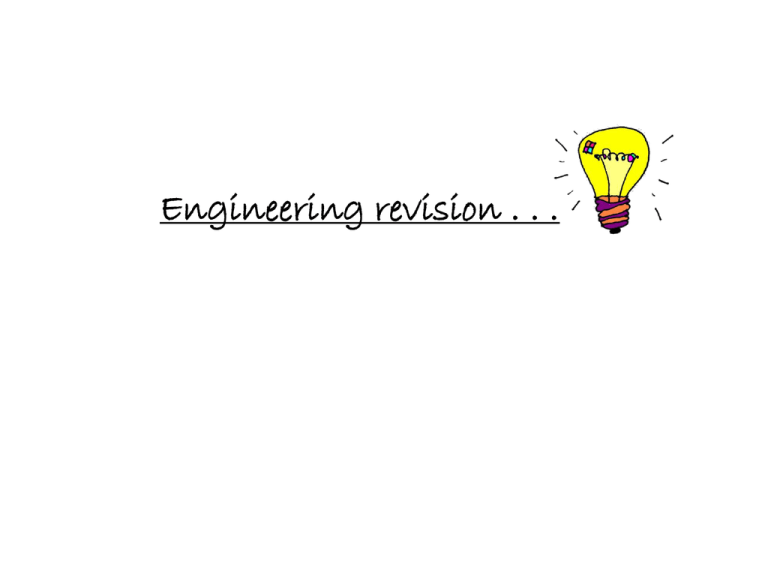
Engineering revision . . . Learning objectives: o Be able to explain why standard electrical and electronic parts are used o Describe a wide range of electrical and electronic components and their uses. o Describe a range of pneumatic components and their uses o List a variety of standard mechanical parts o List the 5 types of Engineering processes o Describe the type of operation carried out by each of the main Engineering processes Electrical and electronic components : Electrical components can be grouped according to how they are used in a circuit It is easiest to understand these functions if we think of a circuit as being a system. The main functions are; inputs, processes, outputs and supporting parts. INPUT PROCESS OUTPUT Examples of components . . . INPUT SWITCH PROCESS OUTPUT THERMISTER FUSE CAPACITOR BUZZER LAMP LDR DIODE SUPPORTING LED RELAY BATTERY MOTOR RESISTOR CIRCUIT TRANSISTOR WIRE INTERGRATED SPEAKER Examples of components . . . INPUT PROCESS OUTPUT SUPPORTING SWITCH THERMISTOR LDR INTERGRATED CICUIT TRANSISTOR LED LAMP BUZZER SPEAKER MOTOR BATTERY RESISTOR FUSE CAPACITOR DIODE RELAY WIRE SWITCH THERMISTER FUSE CAPACITOR BUZZER LAMP LDR DIODE LED RELAY BATTERY MOTOR RESISTOR CIRCUIT TRANSISTOR WIRE INTERGRATED SPEAKER Lesson task: Look at the common electrical components. Sketch each component symbol and explain the function of each one. COMPONENT SYMBOL USE FUNCTION SWITCH (LATCHING) SWITCH (PUSH TO MAKE) THERMISTOR LDR INPUT Pneumatic, hydraulic and mechanical components : Pneumatic systems are powered by gas, normally air instead of electricity to carry out their function Hydraulic systems use liquid instead of electricity Both types of system rely heavily on moving pressure from one place to another The gases used in pneumatic systems can be compressed and the pressure this creates is used to do work Liquids DO NOT compress and are used in systems where much heavier work is required The reason why these systems may be used in some applications instead of electrical: - It might not be safe to use electricity due to the risk of sparks or possible interactions with other electrical equipment. E.g. a common use of pneumatic systems is to clamp tools, open doors or move parts in electrically powered machine tools. - It might be easier to carry out the task needed by the direct force rather than converting electricity to movement. E.g. a common use of hydraulic systems is to push the brake pads in a car onto the brake disks. Forming techniques: There are 5 types of engineering processes: o Shaping o Forming o Surface finishing o Joining o Assembling Shaping . . . Shaping involves pouring or forcing liquid material into moulds. This involves techniques such as casting and moulding. Once this material has become solid it is removed from the mould. This is the only process that can turn material into complex, three-dimensional forms in a single operation. Parts can often require some materials removal after shaping. E.g. this can include material that has been squeezed into any gaps where a part of the mould join together, which is known as ‘flash’. Shaping . . . Sand casting: http://www.technologystudent.com/equip1/alumin3.ht m Die casting http://www.bbc.co.uk/learningzone/clips/castingmetals-die-casting-and-sand-casting/901.html Injection moulding http://www.youtube.com/watch?v=1WjM0it9jI&feature=related http://www.youtube.com/watch?v=eUthHS3MTdA http://www.technologystudent.com/equip1/inject1.htm Injection moulding Process description: Diagram of process: Forming . . . Forming changes the shape or size of the material, but normally does not affect the overall volume of the material. This is normally achieved by applying some form of force to the material, such as hammering, air pressure or a vacuum. Some materials are easier to form if they are heated prior to forming. However, unlike shaping, the material does not become liquid at any stage of the forming process. Forming . . . Strip bending http://www.technologystudent.com/jo ints/desk17.htm Vacuum forming http://www.youtube.com/watch?v=NP LWxxyIJcE&NR=1&feature=fvwp http://www.technologystudent.com/e quip1/vacform1.htm Vacuum forming Process description: Diagram of process: Surface finishing . . . The involves modifying the surface of the part in a useful way. The aim of finishing is normally to improve one or more of the properties of the part, such as its appearance or its corrosion resistance. Finishing processes includes applying coatings, chemical treatments or polishing. The type of finishing process applied will depend upon the materials that the parts are made from the properties needed. Finishing processes may be applied to individual or assembled parts. Surface finishing . . . Painting Plating Anodising Galvanising Etching Polishing Painting . . . Can be used to provide a decorative and corrosion resistant coating for metal surfaces. It is the easiest and cheapest way of coating an item. Paints consist of 3 components: o PIGMENT – this is what provides the paint with its colour o VEHICLE – this is the part that has to form a film when the paint dries and sticks to the surface o SOLVENT – this controls how easy the paint is to apply. It evaporates as the paint sets. All paints can be applied by brushing, spraying and dipping. Plating . . . Uses a process called electrolysis to coat the surface of the metal with a thin layer of material. This means that the part to be coated is put in a bath or tank containing a solution of chemical salts and an anode. The anode is a piece of the metal that will be used in the coating. An electric current is passes through the part, the solution and the anode. This causes a thin layer of metal to slowly build up on the part. At the same time, the anode gradually dissolves away. Used to apply coatings of; nickel, zinc, copper and tin. Anodising . . . This is a plating process which is most often used on aluminium. It involves electrolysis in an acid solution. It provides a durable, corrosion resistant finish. Colour can be added to tint the aluminium for decorative purposes. Anodising is used to make the dielectric films that are used in electrolytic capacitors. Anodised titanium is used for dental implants. Galvanising . . . This process involves dipping metal into a bath of molten zinc. The liquid zinc sticks to the steel and cools to form the coating. It is normally used to mild steel. The zinc provides good corrosion resistance, although the appearance of the coated part is not attractive. Often used for; metal dustbins, buckets and road signs. Etching . . . During etching, selected areas of the surface are dissolved by chemical action. It is commonly used in the production of printed circuit boards (PCB’s), where the tracks needed for the electricity to pass through when the circuit is made are protected from the etching solution. Etching is also used to provide decorative finishes on metals and on ceramic items such as glass. The areas that the chemicals can touch and the amount of time that the chemicals can contact part must be carefully controlled to get the desired effect. Joining and assembling . . . Joining and assembling involves attaching or putting the parts together. This might be achieved by bonding parts so that they are permanently attached or by using mechanical fastenings to hold them together. The joining processes used will normally be specified in the design, as it can have a significant effort on the performance of the product. Joining and assembling . . . Permanent: - Welding - Brazing + soldering - Riveting Temporary: - Threaded fastenings such as; nuts, bolts and screws Adhesives: - Epoxy resin - Acrylic cement - Polyvinyl acetate (PVA) Useful websites . . . • http://skateboardproduction.weebly.com/ind ex.html
